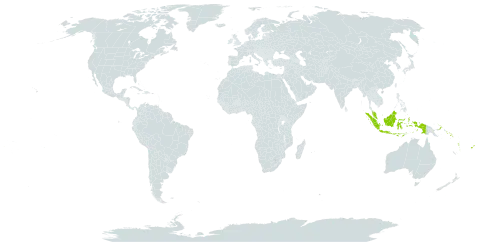Tree, 4-40 m by up to 75 cm ø, sometimes with buttresses. Leaves oblong to broad-obovate or orbicular, 6.5-17 by 3-12 cm, thin-to thick-coriaceous, glabrous; base cuneate to subcordate, decurrent; apex blunt to rounded, rarely short-acuminate; midrib distinctly forked or not, nerves (4-)7-9(-11) pairs; petiole 0.25-1.75 cm. Inflorescences 4-10 cm long, widely branched and many-flowered, glabrous, the terminal parts sometimes sparsely tomentose, flowers often crowded. Calyx 1-2½ mm, outside mostly glabrous, rarely minutely pubescent, inside with or without colleters and/or hairs at the base. Corolla outside glabrous, 4-6 mm long, tube inside usually laxly woolly at the insertion of the stamens, lobes 1.5-2.5 mm long. Anther-cells free for c. ⅓-1/2, hastate, 1.5-2 mm long, corniculate at apex, glabrous to bearded at base. Style 1-1.5 mm, stigma club-shaped, c. 0.5 mm. Fruits clavate, blunt to acute, straight to curved, 1.75-4 by 0.75-1.5 cm, white.
Primary (and sometimes old secondary) rain-and swamp-forests, also on temporarily flooded (freshwater) localities, from sea-level up to c. 2000 m. According to SEEMANN the fruits are much eaten by pigeons in Fiji. Fl. mainly Jan.-June, fr. Febr., July-Sept.
Uses. In the Solomon Is. the macerated bark is applied to skin diseases. In NE. New Guinea, Finisterre Mts, the wood was formerly used for making bowls and plates.

